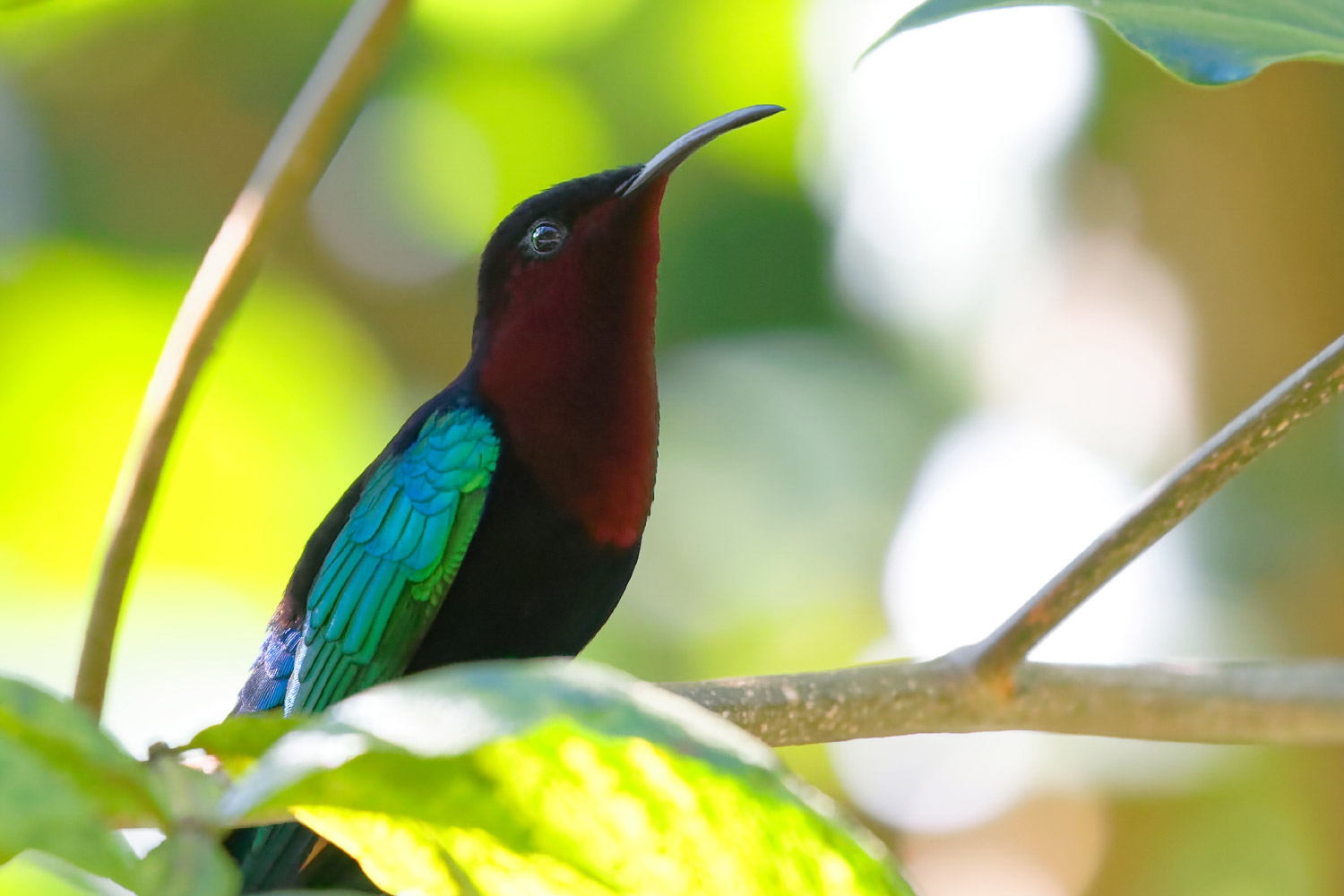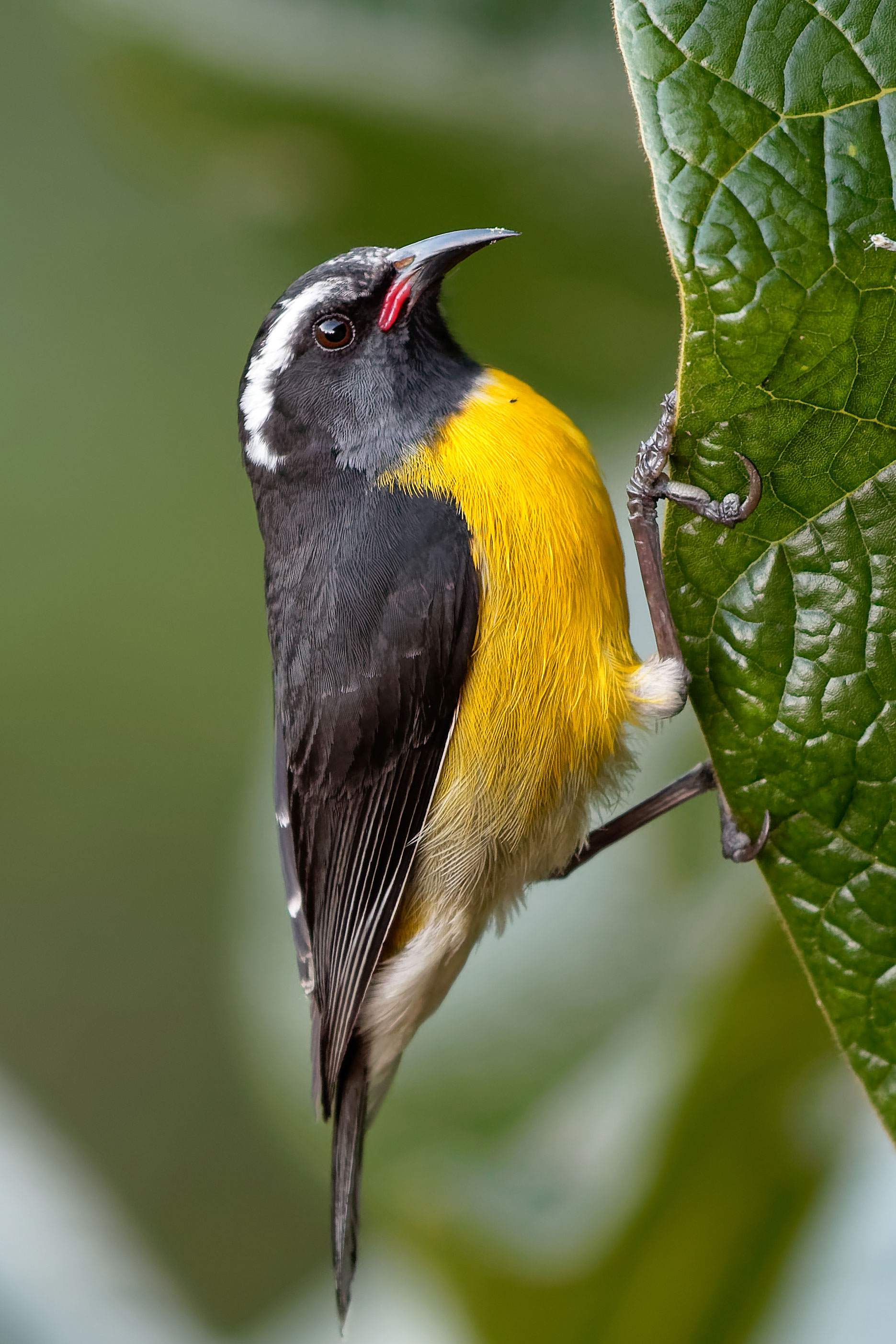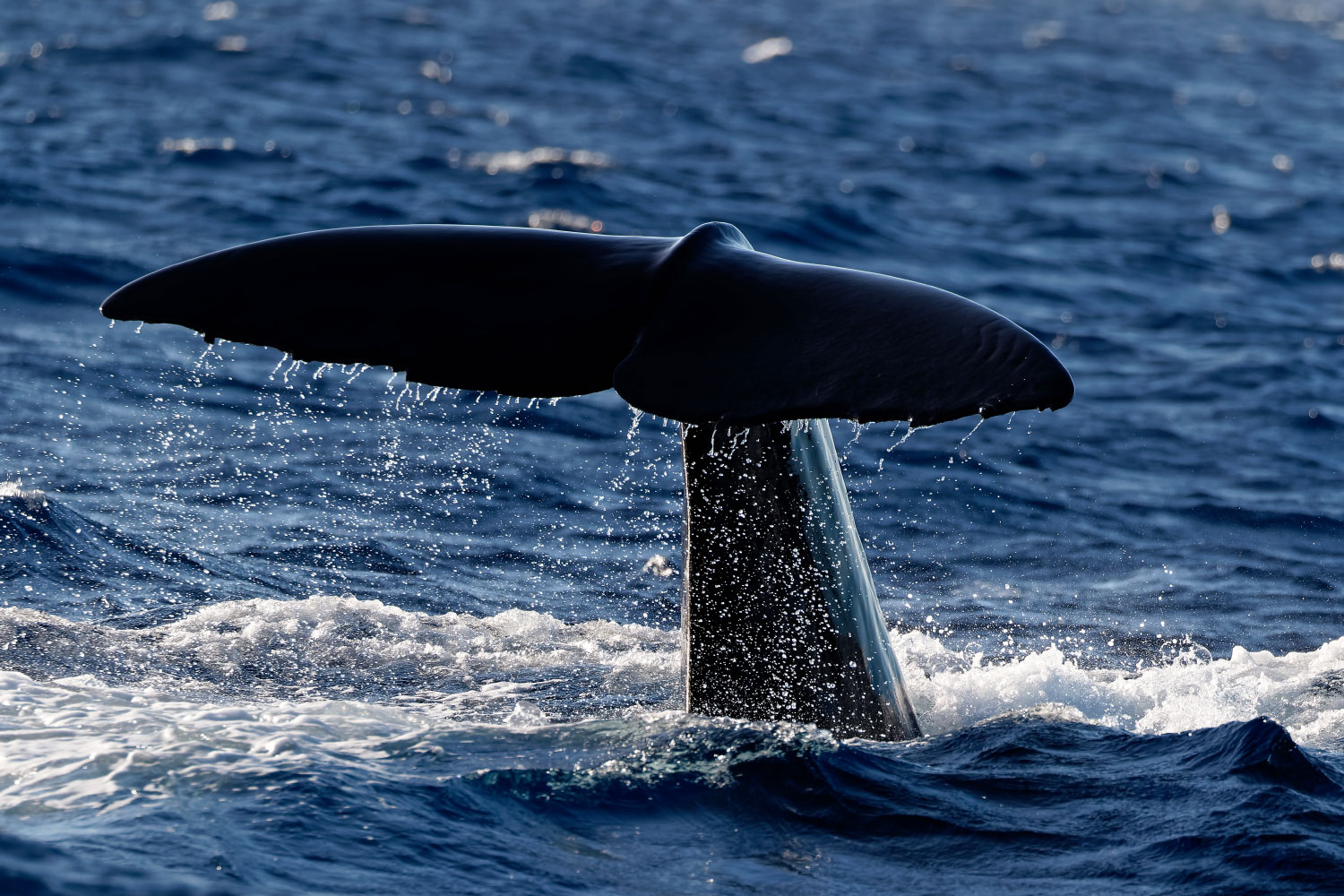A Blue-headed Hummingbird darts towards us, almost too quick to see, and hovers for a moment, electric blue feathers sparkling. As we round an enormous forest tree, buttress roots projecting 3 m from the trunk, a Lesser Antillean Pewee, a small New World flycatcher, flits from perch to perch. The sun warming our backs, we walk past giant ferns, to look out over the edge of a deep canyon, the river rushing distantly below. Lesser Antillean Swifts flutter above the tree-tops, Broad-winged Hawks soar overhead, and endemic Red-necked Amazons (or 'Jacos') fly back and forth across the void, squawking loudly.

Red-necked Amazon has expanded its range since the hurricane (Rod Standing).
It is unusual to stroll in sunlight on the floor of a tropical rainforest, but we are walking the Syndicate Trail in the Northern Forest Reserve on the Caribbean island of Dominica. It is just 16 months since Hurricane Maria, the worst hurricane ever known here, passed through. As 'Dr Birdy', the island's expert bird guide, explains, although the forest has apparently regrown and is once again verdant it will be many years before the canopy fully returns. Some birds are clearly recovering, but what has happened to the rest of this island's unique avifauna?

Giant tree pollarded by Hurricane Maria – note the blue sky visible from the forest floor (Rod Standing).
The arc of the Lesser Antilles divides the eastern Caribbean from the tropical Atlantic. These varied islands are different and separate enough to encourage speciation (Darwin would have been fascinated had he travelled here). One isle stands apart from the others. Like a green jewel in a discontinuous necklace, Dominica is one of the most mountainous and least populated of all the Caribbean islands. Steep volcanic slopes towering up to 1,430 m are swathed in lush jungles. Constant rainfall feeds 365 rivers, according to the islanders. No wonder its birdlife has long been abundant.

Looking inland from the Roseau valley on Dominica’s west coast (Rod Standing).
Dr Birdy points out a patch of Morning Glory, a vigorous climber with bright purple flowers. Having spent many years in the Forestry Service, he seems to know every bush. We have stopped on our way up the flank of Morne Diablotin, Dominica's highest mountain, on our way to the Syndicate Trail. Above the blooms hovers a Purple-throated Carib, a hummingbird found only in the Lesser Antilles. Two curious Plumbeous Warblers also appear, skulking shyly in the shade but smart in their distinctive grey-and-white uniforms. A Lesser Antillean Flycatcher, the local representative of the Tyrant Flycatcher complex, is as bold as brass as it sings in full sunlight.

Purple-throated Carib is one four species of hummingbird found on Dominica and is a speciality of the Lesser Antilles (Rod Standing).

Lesser Antillean Flycatcher singing by the track to the Syndicate Reserve (Rod Standing).
Further up the hill in a citrus plantation, a trio of Jacos searches methodically for fruit, their calls ringing cheerfully through the trees. Dominica's other endemic parrot – its national bird – is the even rarer Imperial Amazon, or Sisserou. The island also shares several near-endemics: Blue-headed Hummingbird is also found only on Martinique to the south, Plumbeous Warbler on Guadeloupe and Marie Galante to the north. Other distinctive species present here are the range-restricted Brown Trembler and Scaly-breasted Thrasher. With such limited distributions these birds are especially vulnerable to natural disasters.

Brown Trembler at Trafalgar Falls (Rod Standing).
On 18 September 2017, the eye of Hurricane Maria passed directly over Dominica. Winds gusting to more than 200 mph shredded the jungles, obliterating the lightly built homes and effortlessly tossing vehicles in the air (some of which were never found). Torrential rain swelled the rivers into destructive torrents which burst their banks and saw them seek new courses through homes, fields, roads and forests. People cowered in ditches or in any concrete structure they could find to shelter from flying debris.

Calibishie in the north of Dominica – only the concrete parts of most buildings survived the hurricane (Rod Standing).
The number of fatalities is uncertain but was, thankfully, miraculously low considering the conditions. It is believed that fewer than 100 people died, though many were injured. As the survivors hesitantly emerged they saw that almost everywhere was brown, not a leaf, twig or branch remaining on bush or tree. Most trees were simply broken trunks. Even forest giants were snapped off a few metres above the base. Mudslides scarred the mountains. In a few hours Hurricane Maria had battered the green paradise into a brown pulp. How could any creature have survived the maelstrom?

Scaly-breasted Thrasher is a secretive species of the tree canopy (Rod Standing).
Amazingly, survive they did. Some have even thrived. The birds that have done well are those favouring newly available habitats, Dr Birdy explains. The numbers of Bananaquits and Antillean House Wrens have exploded due to the thick growth of the shrub layer in the extra light. Green-throated Caribs have increased in response to the sudden abundance of Morning Glory. Jacos have expanded from their former forest home to orchards and plantations in search of food, and appear to be doing well.

Bananaquit is abundant throughout Dominica (Rod Standing).
While Jackos are now much easier to see than before the hurricane, thriving does not always mean more visible. Blue-headed Hummingbird, previously quite easily seen along the woodland edge has spread its range throughout the newly open forest. Though present in good numbers, it is now harder to find. Only Antillean Euphonia (a rainbow-coloured finch) and Ruddy Quail-Dove, both birds of thick jungle, have certainly become scarcer. Presumably, though, as the climax forest structure recovers so too will the numbers of these birds.
The seas around Dominica offer an altogether different kind of natural attraction. Along with an array of tropical seabirds, this is one of the best places in the world to see cetaceans, especially Sperm Whales. In fact, it is the only place where Sperm Whales can be seen year round. The deepest dive ever recorded in the species (more than 1,200 m) was just off the southern tip of the island.

Sperm Whale diving off Dominica (Rod Standing).
Bumping over the waves, we head out into the Caribbean Sea in a whale-watching boat. American Royal Terns, Magnificent Frigatebirds, Brown Boobies and Pomarine Skuas patrol above us, but our eyes are on the horizon. After about an hour a 'blow' is spotted and we slowly approach a Sperm Whale resting on the surface. It appears quite happy with the presence of the boat and allows us to within 30 m. We listen to the 'whoosh' of the exhalations and watch the spray sparkling in the sun for a few minutes as the whale takes slow, regular breaths. Then it arches its back, raises its tail flukes and slides silently into the depths. As we start moving again a calf Sperm Whale breaches the surface ahead of us and falls back with a huge splash.

Brown Pelican fishing off the coast of Dominica (Rod Standing).
The next day our target is a much smaller, angrier body of water. We take on Dominica's ultimate one-day hiking challenge: the trail to the Boiling Lake. This is the second-largest constantly boiling lake in the world – the heat coming from volcanic vents. We follow the precarious path along razor-sharp ridges, down steep valley sides and across the sulphurous, steaming Valley of Desolation. At the furthest point the heavens open, and we return through a tropical downpour, and a mass of red-brown mud. We do not see many birds in the warm rain but we learn about the medicinal and other uses of the jungle plants and discover to our astonishment that there are no dangerous animals or insects on the island. Even the mosquitos are usually suppressed by the constant breeze. Outside the hurricane season, this really is a very safe place to see tropical jungles and their specialist birds.

Traversing a valley bottom on the way to the Boiling Lake, before the rain came down (Rod Standing).
Back on the Syndicate Trail overlooking the canyon, we spend an enjoyable couple of hours scoping the slopes opposite while Dr Birdy shares more of his encyclopaedic knowledge of Dominica's birds. We ask about the fate of Imperial Amazon. With just 300-350 pairs before the hurricane they were never easy to see, he says, but after a brief and worrying hiatus, his sightings have continued at approximately the same rate as before (he keeps a detailed log). Normally dependent on the fruits and seeds of large forest trees, he believes that they may have survived the immediate aftermath of the storm by ascending above the tree line to the upper slopes of Morne Diablotin to forage. If so, presumably they have done this many times across the millenia.
The Imperial Amazons do not appear for us. We listen for their trumpet-like calls but hear only the noisy Jacos – March is the best month to see the magnificent Sisserou and we are a little early. Nevertheless, as we stroll back along the trail to the car we are happy to know that they are still here. Like the friendly people of this resilient island, Dominica's national bird and the rest of the birdlife have somehow survived to thrive again.

Typical Dominican coastal scenery (Rod Standing).

